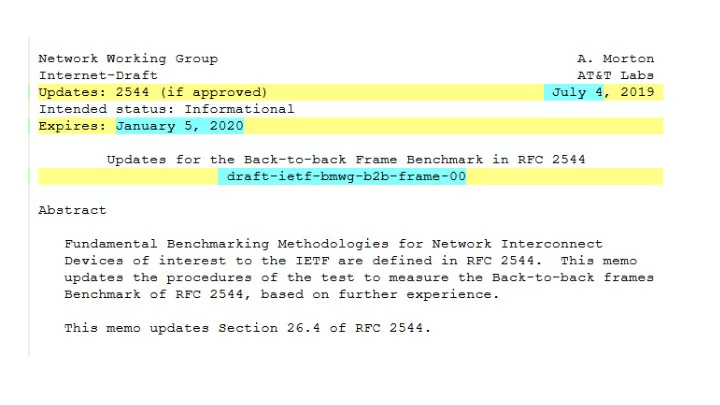

Comments from Maciek and Vratko! • Maciek’s comments addressed in WG -00 version • Some of Vratko’s may benefit from discussion (today) • Maciek asked to move “buffer size matters” to intro: • This is important, it’s how the DUT stores packets during disruptions (like interrupts). DONE • The goal is measuring (ingress) buffer size in front of HeaderProc, per DUT definition in section 3. • This works if there is no other buffering in the system under test. • Suggest to add a paragraph dictating the setup where no egress queue build up is possible.
Somehow, this text (added in 05) was deleted in WG-00 ! Will be restored in WG-01 version!
Maciek’s long, final comments listed areas of “noise” to the measurement:
Maciek’s long, final comments …., also mention the importance of explicitly using TST009 Binary Search w/Loss Verification algorithm, while recognizing other promising work-in-progress:
Broad Comments from Vratko: • Plan to be addressed in WG-01 version • A scenario occurring in practice has suspended processor, but the buffer is being filled more slowly <than b2b>, say at throughput rate. • Deployers wishing to predict the time for the buffer to fill up can use this formula: Real Buffer Time = Corrected Buffer Time * B2B Frame Rate Real Frame Rate • That is why reporting Corrected (instead of implied) buffer time is useful. • !!! Add this calculation ? !!! • Also, it would be nice to name the scenarios and rename the buffer times. • For example, "running buffer time" and "suspended buffer time" • (instead of "implied" and "corrected" respectively). • Does this name change work for others?
Broad Comments from Vratko (2): • B2B processor rate: • For the computation of the corrected buffer time to be correct, real processor frame processing rate (average during B2B test) should be used instead Measured Throughput in the 5.4 formula. • The process rate is not easy to measure directly, especially if the immediate rate varies over the duration of B2B traffic. • I agree that Throughput is a reasonable approximation, but there may be other quantities (e.g. FRMOL [1]), that are either a better approximation, or at least easier to measure. <Frame Rate at Maximum Offered Load, in RFC 2285> • Not sure how much attention other such quantities should get in the draft, as Throughput has the advantage of avoiding some frame sizes. • ACM: I think we need some contributions (experiments) to show the value of this change
Broad Comments from Vratko (3): • DUT vs SUT: • This is related to final items of 4. Prerequisities. • “Therefore , sources of packet loss that are un-related to consistent evaluation of buffer size SHOULD be identified and removed or mitigated .” • ACM: this is material just added in WG- 00… • Do we have a separate document discussing differences between testing DUT and SUT? • Vratko: We should have. • Usually I prefer testing SUT (meaning no extra mitigations), but in this case, for the analysis of the three aforementioned scenarios to work correctly, we need to make reasonably sure the processor is not going to get suspended during B2B test. • Also, I agree that an average result of Binary Search with Loss Verification gives a more realistic process rate estimate than an average result without loss verification. • ACM: B2B Benchmarking for a single DUT retains needed simplicity! • WG ??
Next Steps • Continue WG Discussion • Address remaining comments • Target WGLC at IETF- 106…
Recommend
More recommend